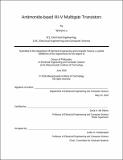| dc.contributor.advisor | Jesús A. del Alamo. | en_US |
| dc.contributor.author | Lu, Wenjie | en_US |
| dc.contributor.other | Massachusetts Institute of Technology. Department of Electrical Engineering and Computer Science. | en_US |
| dc.date.accessioned | 2018-09-17T14:51:35Z | |
| dc.date.available | 2018-09-17T14:51:35Z | |
| dc.date.copyright | 2018 | en_US |
| dc.date.issued | 2018 | en_US |
| dc.identifier.uri | http://hdl.handle.net/1721.1/117833 | |
| dc.description | Thesis: Ph. D., Massachusetts Institute of Technology, Department of Electrical Engineering and Computer Science, 2018. | en_US |
| dc.description | This electronic version was submitted by the student author. The certified thesis is available in the Institute Archives and Special Collections. | en_US |
| dc.description | Cataloged student-submitted from PDF version of thesis. | en_US |
| dc.description | Includes bibliographical references (pages 159-171). | en_US |
| dc.description.abstract | As Si CMOS technology advances, alternative channel materials are under extensive investigation to replace or augment Si in future generations of nanoelectronics. III-V compound semiconductors, such as InGaAs and InGaSb are promising candidates as channel materials for MOSFETs as a result of their extraordinary transport properties. In the past few years, rapid growth in the research of InGaAs n-channel multi-gate MOSFETs has taken place. However, progress in the InGaSb p-channel device research has remained stagnant. In this thesis, InGaSb multi-gate transistor technology has been pioneered and the first InGaSb FinFET has been demonstrated. Critical technological challenges for realizing InGaSb FinFETs have been overcome. First, a dry etching technique of heterostructures containing antimonide-based compounds has been developed. Etched fins and vertical nanowires show smooth, vertical sidewalls, high aspect ratio, and compatibility with the InGaAs system. | en_US |
| dc.description.abstract | Second, a novel antimonide-compatible digital etch technique has been developed which can improve fin sidewall quality and device performance. Lastly, ohmic contacts have been investigated to reduce the parasitic source-drain resistance. The developed contact system delivers a record low contact resistivity. With the integration of the newly developed technologies, InGaSb p-channel FinFETs are demonstrated for the first time. Three generations of InGaSb FinFETs are fabricated following an optimization path for device design and process technology. The most aggressively scaled InGaSb FinFETs, with a minimum fin width of 10 nm and channel height of 23 nm, have achieved a maximum transconductance per device footprint of 704 μS/μm, a record value for any existing antimonide-based p-channel FETs. | en_US |
| dc.description.abstract | In addition, the fabricated FinFETs have been electrically characterized, and device properties such as scaling behavior, impact of channel strain, and OFF-state leakage current have been studied. The work in this thesis has pushed significantly the state-of-the-art of antimonide-based electronic device technology. | en_US |
| dc.description.statementofresponsibility | by Wenjie Lu. | en_US |
| dc.format.extent | 171 pages | en_US |
| dc.language.iso | eng | en_US |
| dc.publisher | Massachusetts Institute of Technology | en_US |
| dc.rights | MIT theses are protected by copyright. They may be viewed, downloaded, or printed from this source but further reproduction or distribution in any format is prohibited without written permission. | en_US |
| dc.rights.uri | http://dspace.mit.edu/handle/1721.1/7582 | en_US |
| dc.subject | Electrical Engineering and Computer Science. | en_US |
| dc.title | Antimonide-based III-V multigate transistors | en_US |
| dc.type | Thesis | en_US |
| dc.description.degree | Ph. D. | en_US |
| dc.contributor.department | Massachusetts Institute of Technology. Department of Electrical Engineering and Computer Science | |
| dc.identifier.oclc | 1052123655 | en_US |
